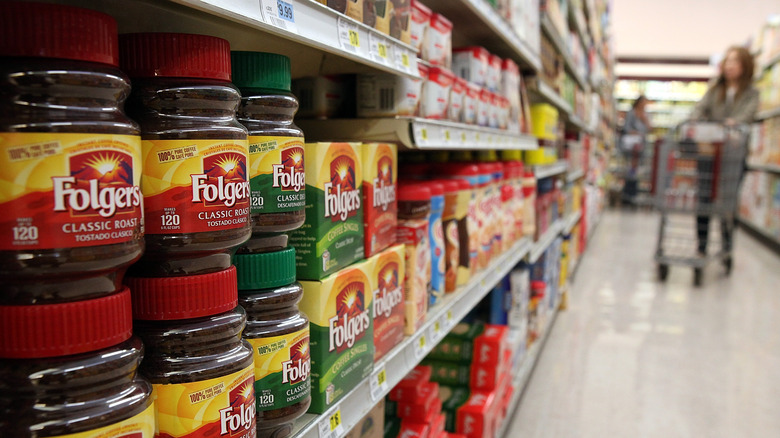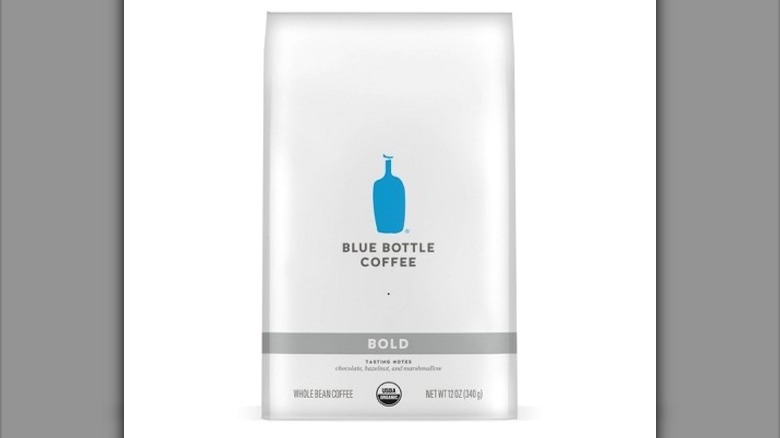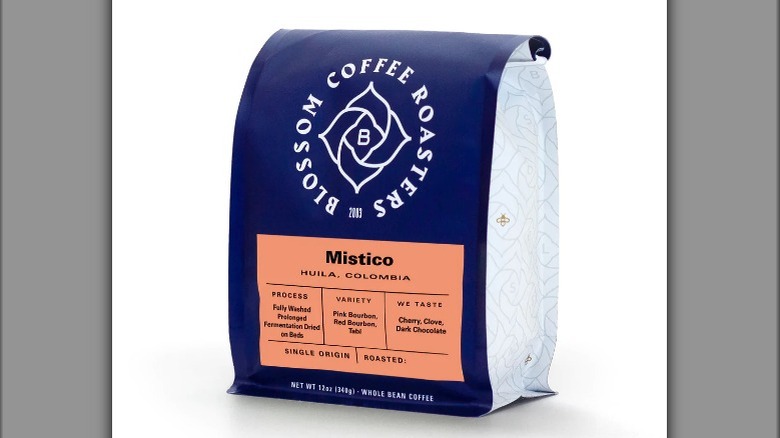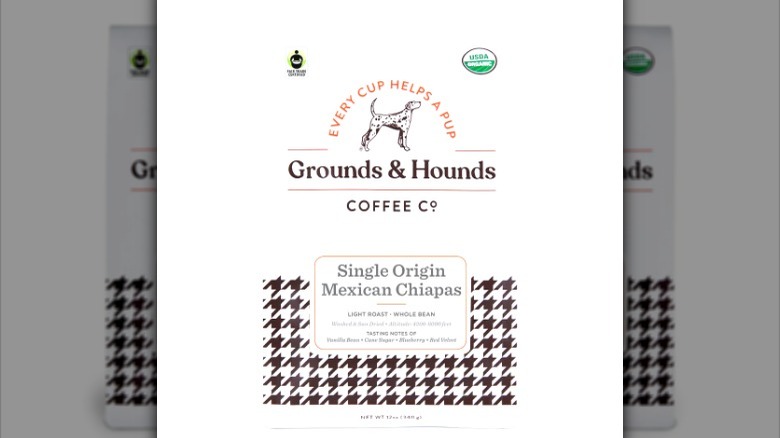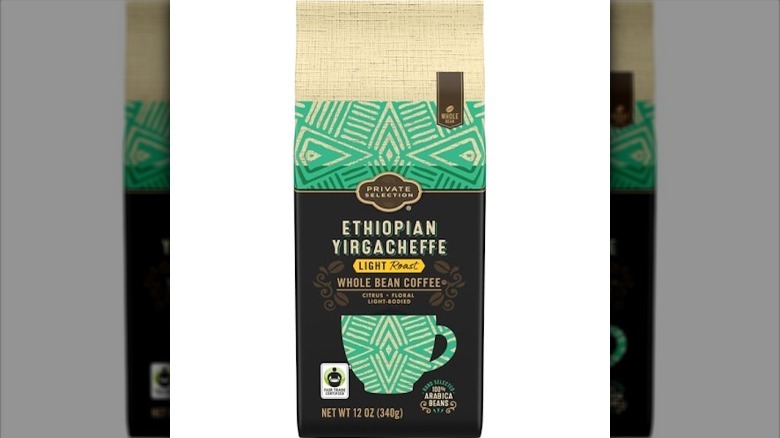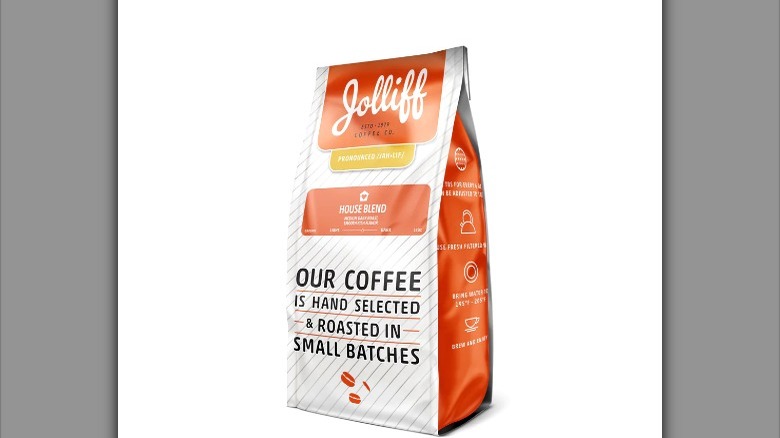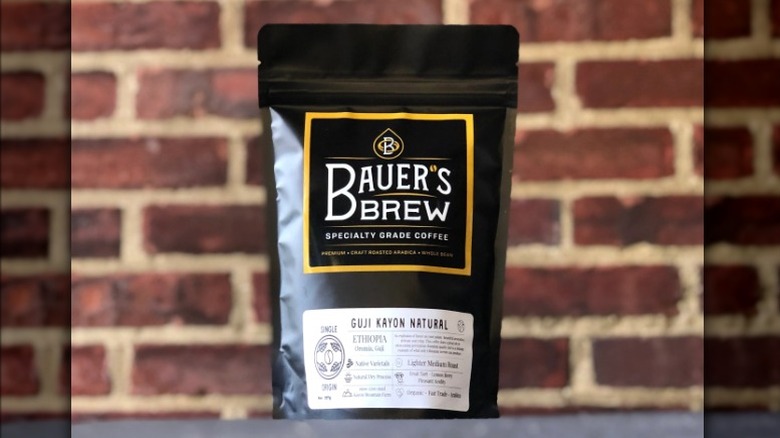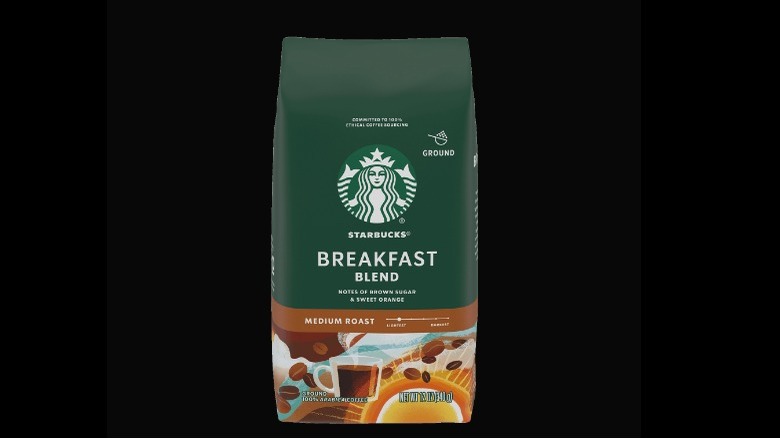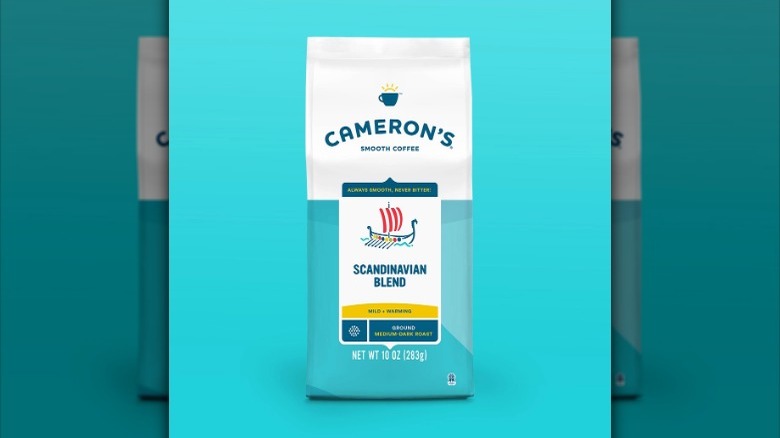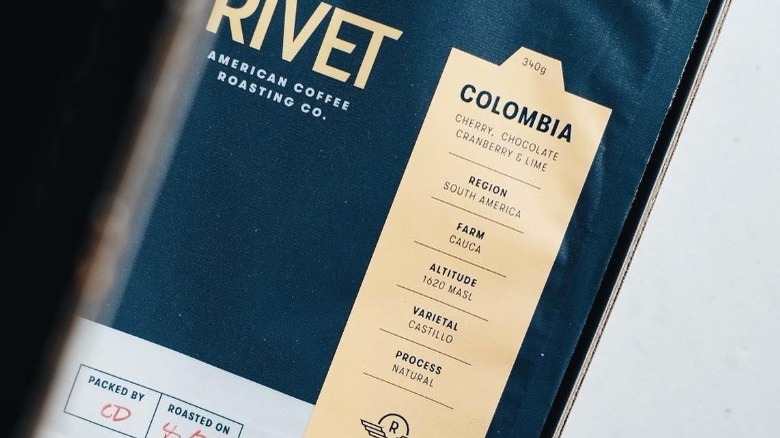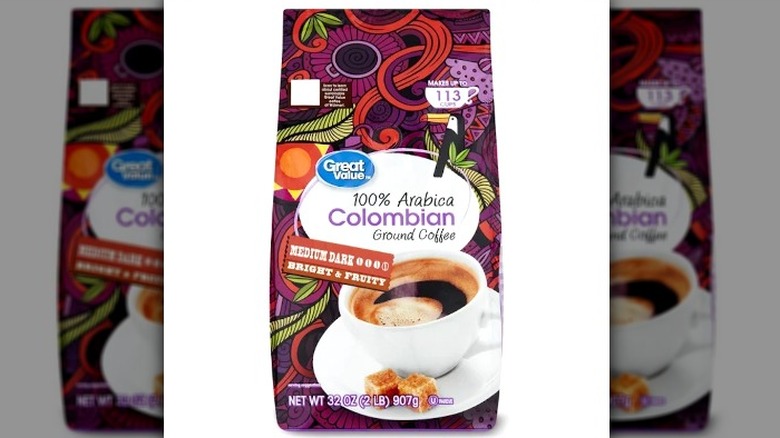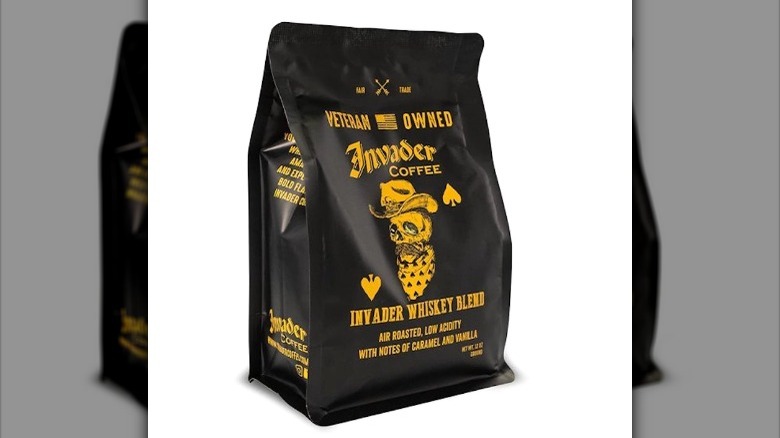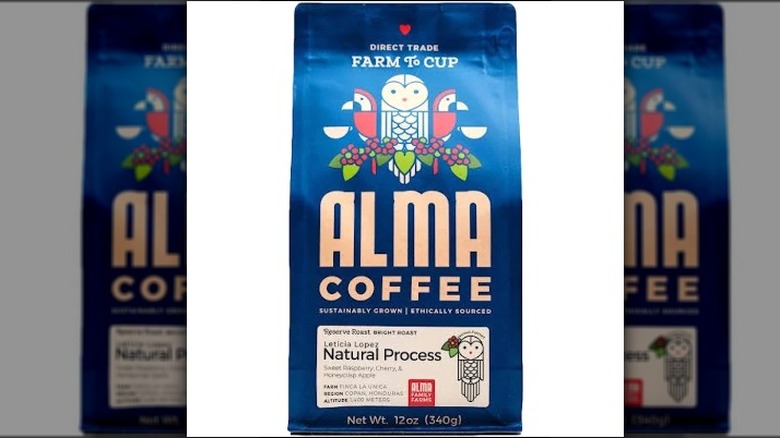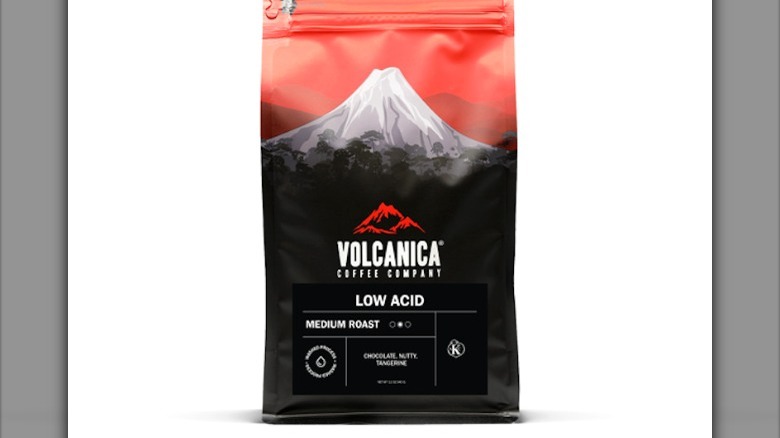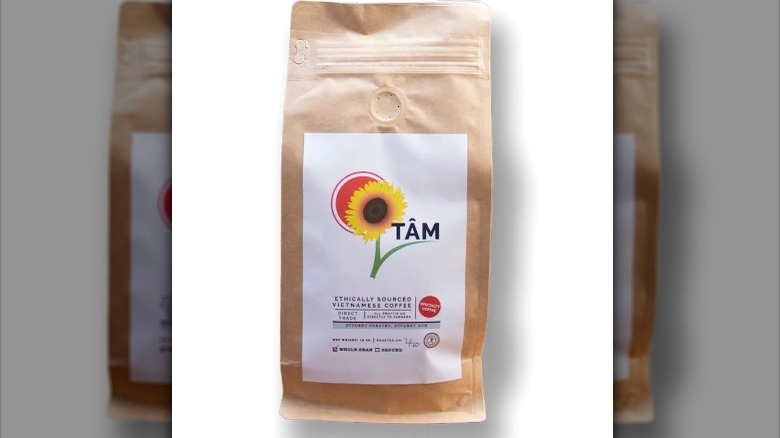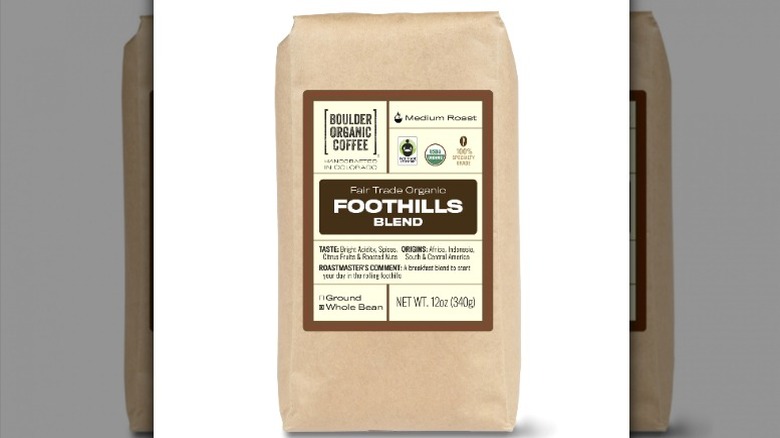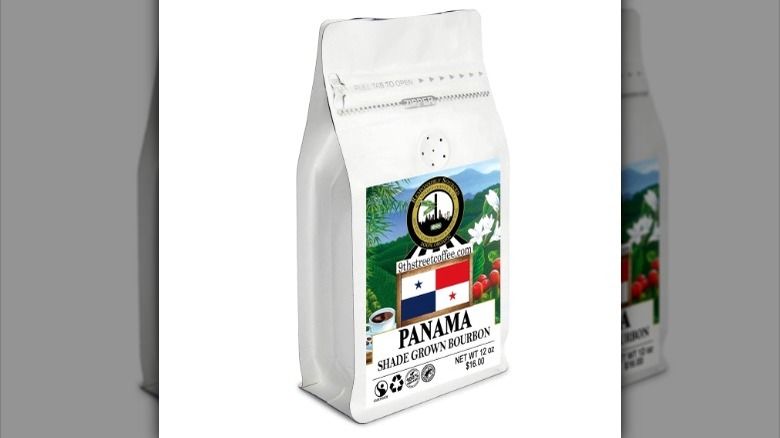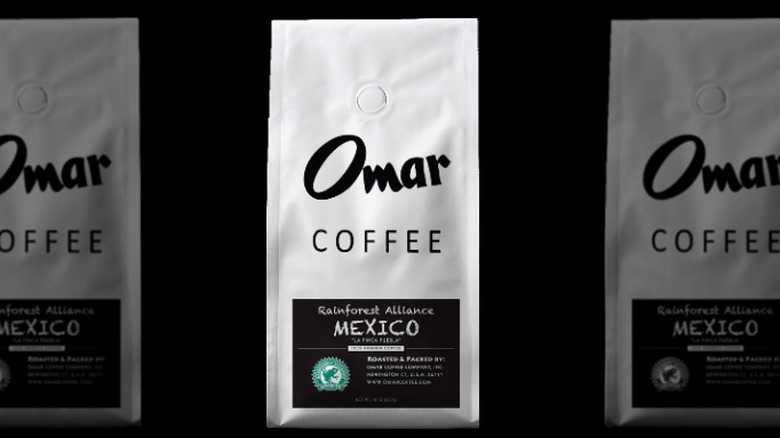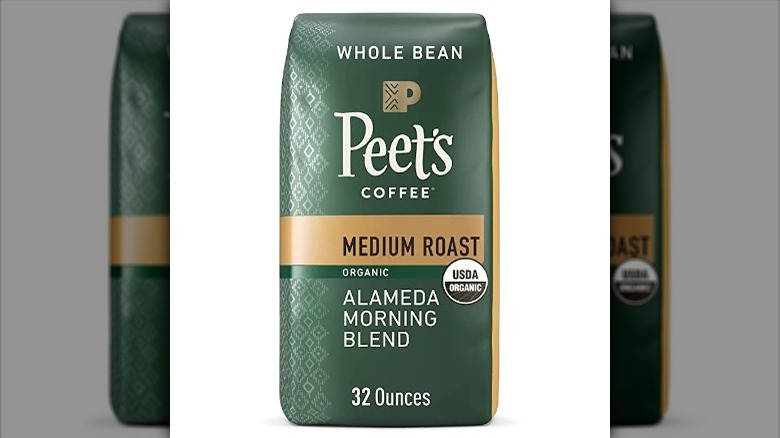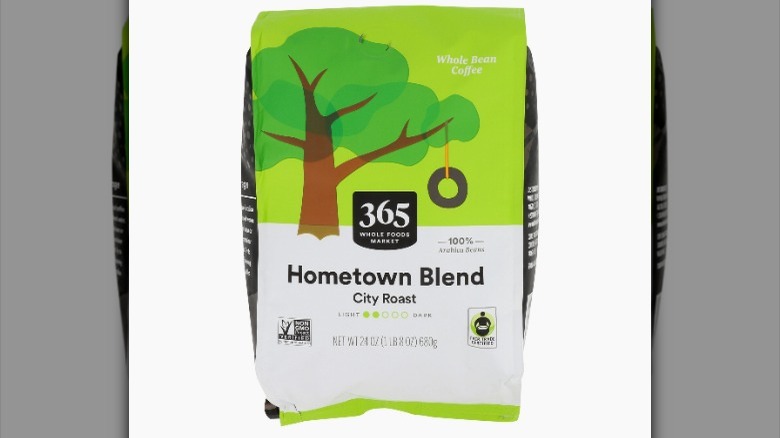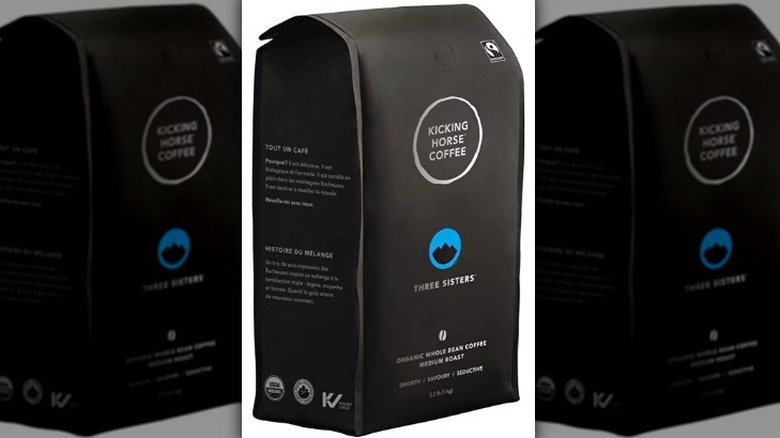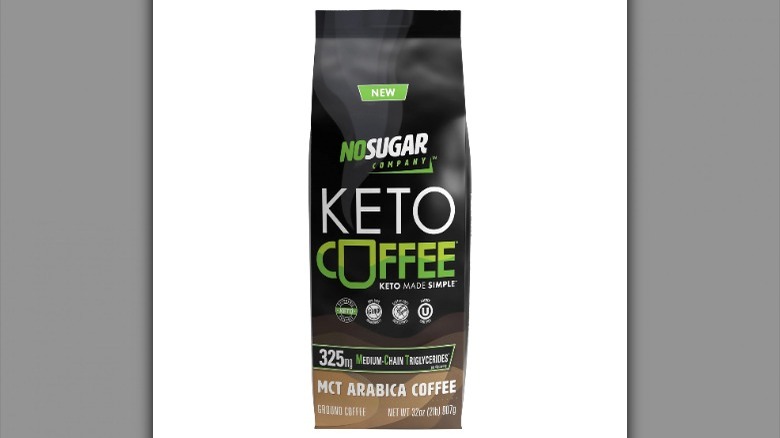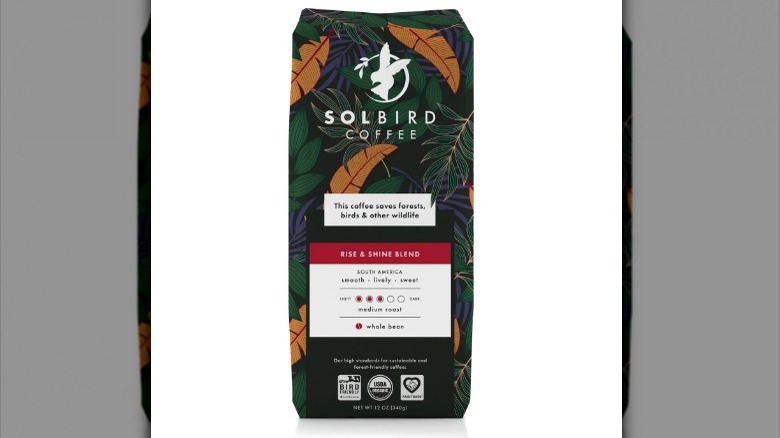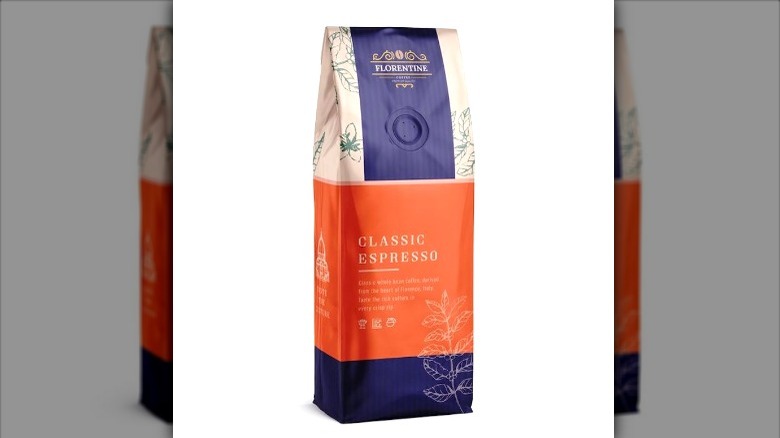23 Essential Coffee Terms You Should Know
We encounter decisions at the grocery store in every aisle. Some leave us helplessly frustrated — like choosing a bad batch of produce or accidentally picking the wobbly-wheeled shopping cart — while others come down to split-second selections, like a frantic Google search for the difference between ssamjang and gochujang. With countless different advertising ploys, trendy packaging, and new products to choose from, the tidal wave of grocery information leaves us exhausted by checkout.
There's no mercy to be found on the coffee shelves, either. We may be destined to always creak down the aisles with our rickety buggies and frequently find the unlucky molded potato, but there's at least some preparation that can take the guessing out of groceries. We compiled a guide to all the coffee packaging jargon you're likely to find among the java aisle's many brands, bags, and boxes: Labels like roast type, flavor, origin, and altitude, to name a few. Use this list to shop for our favorite caffeinated commodity with more confidence, so you can spend more time poring over dish soaps and deli meats instead.
Bold, intense, or mild
Terms like bold, intense, bright, or mild may be some of the most common ones seen on many types of coffee. These vague descriptors provide a general idea of what a coffee's flavor profile is expected to be and, just as the words' definitions indicate, how strong that flavor will be. For example, bold and intense are more than likely describing a dark roast coffee, per Coffee Kiwi. These roasts are generally more bitter, smokier, and richer in flavor due to their longer cook times, leading to that recognizably bold taste.
On the other hand, bright coffees are probably light roasts. Light roasts are less caramelized or burned than dark roasts, so more of the natural flavors and acidity from the raw bean are evident, according to Sweet Maria's Coffee Library. This lends a more citrusy, fruity flavor that may be described as brighter compared to intensely bittersweet dark roasts. Mild as a descriptor may be more of a wild card; it may be synonymous with bright in some instances, but it may also describe a medium roast that is not strongly bold or bright either way, splitting the difference for a more universally palatable brew (via MaxiCoffee).
Tasting notes
Tasting notes are exactly that — the different flavors that the producers believe you will experience when drinking their coffee, per Beandeck. Obtaining a coffee's tasting notes isn't quite as simple as sipping on a freshly brewed cup; instead, producers, roasters, and buyers partake in a process called coffee cupping (via Perfect Daily Grind). Producers will pour hot water over freshly roasted grounds and leave it to steep for up to five minutes. The mixture is stirred and cooled, spooned up, slurped, and spit out. They're looking for a coffee's acidity, mouthfeel, sweetness, and aftertaste and translate what they taste into the tasting notes we are familiar with — notes like caramel, hazelnut, dark chocolate, raisin, graham, cherry, and the like.
On a coffee bag's packaging, you might see "we taste," "notes of," or simply "tasting notes." Descriptors like blackberry and honey are probably indicative of a light roast, per JavaPresse, and you've probably picked a dark roast if you see words like caramel and chocolate. While you shouldn't expect the same flavor intensity of these notes as if you were, say, biting into a chocolate bar, they should still be evident in coffee that's been properly brewed. You can also try cupping at home if you'd like to experience the tasting notes like a coffee producer.
Single origin
Single origin is likely to appear on some of the higher-end coffees in the grocery store or on bags for sale on café shelves. What does it mean? Why don't we ever see double, triple, multi-origin claims? This phrase is important for many coffee producers and enthusiasts: It means that the beans in that bag you're holding can be traced back to a single country or region, perhaps even the same farm, paddock, or crop, according to Perfect Daily Grind. In these cases where the source of the coffee is more specifically defined, you may see phrases like "single estate" or "single farm" instead.
So why do coffee lovers appreciate single origin roasts? According to The Perk Blog, it's the beans' stronger, more exotic flavors that hold the appeal. Java enthusiasts also enjoy the opportunity to explore, compare, and contrast the flavor notes of different regions and origins. The coffee in the pictured packaging, for example, comes from the southernmost Mexican state of Chiapas — which is likely to taste differently than an Ethiopian Yirgacheffe.
Origin country
You're likely to know which country your brew came from just from taking a glance at its packaging. Did you know that over 70 countries produce coffee? However, the vast majority of the world's java comes from just five nations — Brazil, Colombia, Ethiopia, Indonesia, and Vietnam, according to World Economic Forum. Brazil leads the charge with a market share over 37% in 2020, more than double Vietnam, the second-largest producer. Some origin locations may also be regions or states within a place — like the Mexican state of Chiapas or the Indonesian island Sumatra, famous for its coffee production.
Does the origin country really matter? Each nation has its own unique set of growing conditions, including soil, altitude, rainfall, and climate. Different cultures will also abide by their own traditional practices for harvesting, washing, and drying coffee, which will sway the beans' flavor profiles, too. As the Latin American Coffee Academy explains, you might notice variations in aromatic profiles from continent to continent. Hawaii's coffee, for instance, may be rich and voluminous thanks to volcanic soil and abundant rain, while East African cultivars are known for their fruitiness. Many avid coffee drinkers gravitate to the origins that produce their preferred tasting notes the most.
Small batch
You might appreciate hand-carved furniture over mass-produced options in big box stores. You might opt to make homemade cookies rather than store-bought. An original work of art is generally perceived as more valuable than a print. There are endless examples where we tend to prioritize goods made slowly and thoughtfully by human hands over those made by the hundreds or thousands in a factory. Plenty of coffee enthusiasts share this sentiment, and that's why you're likely to see the phrase "small batch" on certain coffee products at the grocery store. Large brands must roast coffee in as big of batches as possible to meet demand, but smaller businesses have the liberty of moving their products through in smaller amounts.
Why does the volume of beans roasted at a time make a difference? Roasting is just as important as growing and brewing in the coffee cycle, and how a roaster chooses to execute this process creates subtle nuances in the final product's flavor. As Common Sense Coffee explains, a great comparison is trying to warm up an overflowing plate of food in the microwave. The food on top will come out boiling hot, while the food underneath is barely warm or still cold. Similarly, large batches of coffee will not roast evenly throughout, but heating up the roaster is not the answer. Instead, small batch coffees are tailor-roasted by an attentive roaster that has more control over the coffee's final flavor, quality, and freshness.
Specialty grade
If the grocery store coffee you're eyeballing is specialty grade, you can expect coffee with the richest flavors and most complex profiles, per The Specialty Coffee Company. Specialty coffee is likely to reflect its premium grade in the price tag. The beans are often harvested in micro lots from the same farm or even land plot. A bag of specialty java was likely grown at a high altitude and carefully tended by the farmer, then sold and small-batch roasted.
Specialty grade may sound like a subjective system, but there are specific barriers to entry in place. A specialty grade coffee is first graded on its defective beans. There are two types of coffee bean defects: Primary defects, which are beans that are black or sour (essentially have "gone bad"), and secondary defects, which are beans that are broken. In a roughly 12-ounce sample, a specialty grade coffee must have no primary defects and no more than five secondary defects (via The Specialty Coffee Company). The beans are then roasted, ground, cupped, and scored by a certified coffee taster or a licensed grader from the Quality Coffee Institute. The coffee is scored on a 0-100 scale; anything under 80 is not specialty quality, scores between 80 and 84.99 are the lowest tier of specialty coffee, 85-89.99 is mid-tier specialty coffee, and anything above that is outstanding specialty coffee.
Blends
While a single origin coffee is one harvested from a singular place, blends exist at the opposite end of the coffee-harvesting spectrum. Most retail coffees are blends of some form, says North Star Coffee Roasters, depending on how an individual roaster, producer, or consumer defines differing origins. This idea can technically get very specific. For example, a bag of coffee harvested on the same farm that spreads up a mountainside could be argued as a blend due to the varying altitudes — to avoid splitting hairs, though, these are probably considered single origin.
Blends are not necessarily worse than single origins. Rather, they are usually curated by a producer to achieve a certain flavor profile, to maintain coffee products at a certain price point, or to produce at high volumes, per North Star. They select batches from different farms, regions, or countries to combine the tasting notes known to come from those places. A very popular example is the beloved breakfast blend, which is usually crafted out of light and medium roasts that are mild in flavor and higher in caffeine (via Bean Ground). The idea is that the milder taste is easier to palate first thing in the morning, and the stronger caffeine jolt helps get you going.
Ground and whole bean icons
Have you ever brought home a bag of coffee only to find it's whole bean, and you don't have a grinder? This is a massive disappointment when all you want is a kick of caffeine, but it doesn't have to be that way. While some brands simply state "ground" or "whole bean" on their packaging, others use symbols that may go missed at first. Many grocery store coffee brands will have a silhouette of a whole coffee bean to indicate that its contents are not ground, but the icon for coffee grounds is a bit more difficult to spot.
As shown on the pictured bag of Cameron's coffee, the icon in the bottom-left corner means the coffee has been ground. These icons may appear as dots arranged in a circle, or a spoon appearing to scoop up coffee. When in doubt, you should be able to determine what's inside by giving the bag a squeeze.
Altitude
You've likely seen a couple of brands boast the altitude at which their coffee is grown. You've probably never been all that concerned with what altitude poultry is raised at, or if an apple orchard is halfway up a mountain versus by the seaside, so why does that make a difference with coffee? Coffee plants grown at higher altitudes are regarded as better quality — but why? As Stoked Roasters explains, beans grown higher up from sea level typically mature at a cooler temperature. Coffee plant development is slowed; when given more time to mature, more energy is driven to bean production, which produces a richer, more complexly flavored coffee. High-altitude coffee plots also tend to have better soil drainage, which leads to more concentrated flavors because of less water in the beans.
There are even more specific terms regarding altitude you may spot on different coffee packages. As shown in the pictured brand, the abbreviation MASL represents meters above sea level. Altitudes that are marked with SHB (super hard bean) or Altura (Spanish for height) were grown at 1,300 MASL or higher. Because of how long these beans will take to develop, they will have the strongest terroir, which is the tasting notes created by the beans' natural growing environments. Higher altitude coffees are more acidic, commonly exhibiting fruity or floral flavors. Lower-altitude coffees will have less terroir, making a smoother, milder brew.
100% Arabica beans
Coffee grown in Brazil, Colombia, Guatemala, Ethiopia, or India is more than likely Arabica beans — the coffee that makes up around 60% of the world's java, says Sprudge. Arabica is, generally speaking, more finicky than its considered-inferior cousin, Robusta. Arabica requires very specific environmental conditions to thrive, its plants take longer to mature, it grows at a higher altitude, and is considered to be of a higher flavor caliber, which is why many brands tout "100% Arabica" labels on packaging. Even coffee-producing countries without the ideal growing conditions, especially the altitude, aren't able to produce much Arabica; Robusta coffee plants can grow as low as 600 MASL, explains Henry's House of Coffee, while Arabica won't be found below 800.
Arabica and Robusta aren't always mutually exclusive within your bag of grocery store coffee. Specialty coffees are almost always 100% Arabica, though some producers blend the two to capitalize on the different species' strengths: The sweetly complex and balanced flavor from Arabica and the caffeine and crema from Robusta. Robusta is also hardier to disease, Sprudge explains, so even modern Arabica hybrids may contain some genes from Robusta.
Speaking of flavor, these two species are very different. Arabica contains twice the amount of flavor-deriving sugars, and Robusta contains twice as much chlorogenic acid as Arabica, which experts say lends to a woody, bitter taste, per Harry's House. Arabica plants are self-pollinating, while Robustas cross-pollinate; cross-pollination can cause more inconsistencies in flavor from plant to plant and batch to batch.
Air roasted
Traditionally, coffee beans are cooked in a roasting machine. A constantly-moving arm agitates and stirs the beans in the large roasting drum so that they're evenly heated and consistently cooked by the hot air shooting through the drum. This is how most, if not all, large-scale coffee producers will roast their product, but some specialty roasters choose a rarer way. As a quicker and more novel alternative to roasting beans in a drum, a coffee brand can air roast its beans. In doing so, the air roaster machine floats the beans over continual currents of hot air instead of stirring them with an ever-moving arm, per Coffee Affection. The beans will naturally tumble as they float in the air current, leading to a more even cook with less time needed.
Does this matter to someone who just wants the best-tasting at-home cup of coffee possible? According to Coffee Affection, it matters quite a lot. In traditional coffee roasting, the outermost skin of the bean — the chaff — may get trapped in the drum when it cooks off. The chaff may then burn and stick to the beans, or burn and put off a thick smoke that creates a harsh, bitter flavor profile. Air roasters are able to suck the cooked chaff away from the hovering beans with an overhead collection chamber. And since each side of the bean is equally and more simultaneously exposed to the hot air, Coffee Affection purports that air roasted beans turn into a better-tasting brew.
Process
The process method is yet another point on a coffee bean's journey from the farm to your cup that impacts its overall quality and flavor. It's not a glaring enough taste change between each process method to be overshadowed by, for example, added creams, flavors, or improper brewing. But you are likely to notice small flavor nuances if you drink a lot of black coffee and decided to try out brands that use different processes. According to Drink Trade, two of the most common processing methods are washed and natural.
When coffee cherries are processed through washing, the fruits' outer layers of skin and pulp are loosened and removed either through underwater fermentation, dry fermentation, or high-pressure water jets that forcefully blast off the cherries' outer layers. Using fermentation to loosen and fall away the skin and pulp leads to subtle changes in the final coffee bean's flavor, but it is likely a negligible difference to most coffee drinkers. Washed coffees are normally bright and mild.
The natural process involves leaving coffee cherries to do what nature intended. The whole fruit ripens together, eventually completely drying out to the point where the outer layers can be manually removed. Natural process coffees are often described as bigger-bodied than water process, with more prominent notes like nuts and chocolate.
Low acidity
If you ever read up on coffee or studied packaging lingo, you've almost certainly seen a brand boast its coffee as low acid. What does a coffee's acidity mean and why does it matter? Acidity is one of the four tasting characteristics of coffee, along with aroma, body, and flavor (via Starbucks). This descriptor isn't used as an indicator of the coffee's actual pH levels — it's only meant to further explain the flavor, and is influenced by the bean type, roast, brewing process, and quality of the water used to make the coffee.
Acidity varies across different origins and roasts. The darker the roasts, the less of an acidic bite a coffee will have; Arabica beans have a naturally higher acidity. As Verena Street Coffee explains, when you sip coffee, the brew's acidity is felt in the front of the mouth as well as with a dryness toward the back. High acid coffees may taste sharp, crisp, tart, or like dry wine. For a gentler, less intense, less full-bodied coffee, give a low-acidity product a try. High acidity coffees are often produced in higher altitude growing climates, like Guatemala, Costa Rica, and Kenya. The best low acid varieties are Sumatra and Brazilian.
Low-acid coffee also offers purported health benefits such as decreased heartburn, help with GERD symptoms, and less chest pain, via MIC. Low-acid coffees range from 5.6 to 5.2, according to Volcanica, only a few degrees above the average coffee pH.
Direct trade
A circular label with an arms-up silhouetted man in the center is the Direct Trade certification, and one of many humanitarian, sustainable coffee market emblems you'll find on coffee packaging. It's different from fair trade certification, but still arguably very important: Direct traded coffee is a commodity that has met the set of international Direct Trade standards that eliminate expensive middle-men steps on the coffee's economic journey. Farmers are connected straight to roasters and producers to ensure a more equitable profit for the farmers and a more trusting relationship for both parties (via Direct Trade).
The money saved in a direct trade relationship that would traditionally be spent on a number of intermediary expenses and fees is usually reinvested in the farmer's operation, including social welfare and community support, technical and mechanical reinforcement, and education. Roasters can reap a higher yield on the product at their stage, too, making direct trade beneficial on both ends of the supply change while showing an active investment in the economic development of coffee farming communities.
Fair Trade Certified label
There are a number of labels that indicate the coffee you're eyeballing on the grocery store shelf is fair trade certified. At least five major fair trade certification organizations investigate coffee producers for fair trade compliant practices, but the most recognized label is Fairtrade International's blue and green circular logo. There are several others, including the puzzle-piece-like logo of the World Fair Trade Organization or the person holding a bowl in the Fair Trade Certified emblem. Other than coffee, bananas, chocolate, tea, and flowers are just a few examples of things we regularly buy that may have been examined by fair trade certifiers.
So what does this label mean for your coffee? A fair trade emblem signifies a brand that has been vetted for livable wages up and down its supply chains, no child labor or exploitation, environmental consciousness, and safety in the workplace, per Fairtrade.net. In the coffee market, fair trade organizations examine farms, factories, and distribution hubs for harmful practices. You are likely to notice a higher ask for fair trade coffee — this product is often more expensive because farmers are paid a premium for their products to ensure they're meeting a sustainable wage after a long history of exploitation and unfairness in the global coffee industry.
Shade-grown/full-shade
Humans appreciate the benefits of shade — it protects us from the unforgiving sun, warding off skin damage and aging. While coffee beans don't need to worry about sun spots and wrinkles like we do, coffee plants still benefit from being left to thrive in an environment guarded against the sun's harsh rays. If your coffee is packaged with a shade-grown or full-shade claim, this means its plants were sewn into an existing ecosystem rather than replacing it, per Discover Magazine. The coffee is grown alongside the same root systems and under the canopy of the vegetation that has already claimed the space, allowing for minimized environmental impacts and reaped cohabitation benefits. Shade-grown coffee is good for the earth: The added foliage cools the trees and air, retains moisture, supports native flora and fauna while battling back invasive pests, and retains soil.
What does a life free of sunbathing do for coffee beans? The coffee fruits, when not exposed to as much direct sunlight, don't lose as much water to evaporation. The cherries in turn can take longer to ripen, developing more concentrated sugars that are responsible for the robust coffee flavor and a higher quality brew overall.
Rainforest Alliance Certified label
Have you ever noticed a cute little tree frog on your coffee packaging? When coffee is Rainforest Alliance certified, you'll see a green circular icon with a tree fog inside it. This seal has only been on grocery store shelves since 2020, so it may be one you don't recognize yet (per Rainforest Alliance). The Rainforest Alliance is a nonprofit organization that puts its stamp on products that are sourced through more sustainable business practices. Rainforests are certainly part of this effort, but it involves much more. This might include coffee brands that focus on a small climate footprint, swear off deforestation, advocate for the advancement of human rights, or support farmer livelihoods with livable wages and safe working conditions.
The Rainforest Alliance stamp doesn't necessarily guarantee a certain quality or taste of coffee, but if environmental and social issues are of high priority for you, products with this label will align with those values.
USDA Certified Organic label
You're more than likely familiar with the USDA, or at least what it stands for — that's the United States Department of Agriculture. There's also a good chance you've seen the agency's organic certification stamp on many grocery store products. As the USDA explains, the organic label indicates an item that was produced with best farming practices. These practices support ecological balance, protect the native insect and flora populations, and encourage the use of cycled on-farm resources.
A coffee brand must undergo pest and weed control and soil quality studies to receive the USDA seal, and any brands that use genetic engineering, irradiation (exposure to radiation to eliminate pests), or synthetic fertilizers are disqualified. A brand's farming practices must be shifted to rely on biological, natural, physical, or mechanical management, and stay true to those practices for three years before a harvest can be USDA organic certified. If the packaging states that the coffee is 100% organic, USDA says, this means that no contents are nonorganic. A seal that just says organic is no less than 95% organic product.
Non-GMO Project Certified
Many people are passionate about the presence of GMOs, or genetically modified organisms, in the food and drink they consume. Animals, plants, or microorganisms can have their DNA modified through genetic engineering, explains the Food and Drug Administration. In doing so, researchers are attempting to develop goods that last longer, are resistant to disease, and taste better — think of genetically developing apples that resist browning or drought-tolerant crops. In addition to the FDA, the Environmental Protection Agency (EPA) and the USDA also regulate GMO products. GMOs, the FDA says, are safe to consume and are closely monitored by these federal agencies.
Some disagree and argue that there aren't enough reliable long-term studies into the consumption of GMOs, hence the Non-GMO Project and its rectangular emblem with a butterfly perched on a branch. The Non-GMO Project alleges that GMOs are responsible for the increased use of toxic herbicides and the creation of "superbugs" and "superweeds," which are resistant to insecticides and herbicides.
The Non-GMO Project will seal products through a third-party verification company that are found to not contain any GMOs. As of this year, you may see labels disclosing products that are made with GMOs just as much as those that aren't, per the FDA. This label is a green circle that displays a crop field under sunny skies and reads "derived from bioengineering."
Kosher Check label
Have you ever seen kosher certification on a food or drink product and wondered what it meant? Kosher is an adjective describing products that meet Judaism's longstanding dietary laws. The main points of the 3,000-year-old kosher diet are that the consumption of pork and shellfish is prohibited (via Talking Point Israel). But even products that don't contain these meat products, like coffee, can be kosher certified.
When coffee is kosher certified, the producer has proven that the facilities and utensils used to roast and package the coffee have not come into contact with any meat products, and that no non-kosher products have been processed using the same equipment. A common kosher certification you might see on grocery store coffees is the Kosher Check, the rightmost label on the bottom of the pictured coffee's packaging, which looks like a K and a V merged together. Just about anything can be certified kosher — spices, produce, alcohol, snack products, coffees, and teas are just a few examples.
MCT oil
Especially if you've ever wandered into a health food store, you've likely started to see coffee packaging that claims to include something called MCT oil. This trendy diet ingredient stands for medium-chain triglycerides. According to MyRecipes, this substance, usually derived from coconut or palm oil, is clear ad tasteless. Brands claim that it will help the consumer burn calories, perform exercise, suppress their appetites, and boost their metabolism. The ingredient is usually sought by people partaking in the keto diet, a fad nutrition lifestyle that generally isn't recommended by healthcare professionals (per the Mayo Clinic).
MCT oil is one of the staple ingredients in the popular bulletproof coffee, the health benefits of which remains an open question. It really depends on where you look — this report found that MCT oil supported weight loss in some consumers, increased levels of heart-protective cholesterol in this study, and decreased an inflammatory marker known for elevating the risk of heart disease according to this analysis.
Bird Friendly certified label
Protecting forests and ecosystems is critical to maintaining bird habitats. A 2019 National Geographic report found that tropical agriculture industries, like coffee, are largely to blame for loss of bird species. Shade and tree canopies make a huge difference in bird habitat sustainability, and clearcutting an ecosystem to grow coffee in the full sun will destroy those precious canopies. Increasing shade cover at coffee farms was discovered to help by a little bit, but not nearly as much as a sweep of full-shade, mature forest.
The mission of labels like the Smithsonian Bird Friendly certification is to protect that critical habitat and support biodiversity. If you see the bird friendly label, you know that the farmers are committed to bird and other wildlife habitat conservation through sustainable practices. Some of the best bird friendly coffee comes from East African producers like Ethiopia or Kenya, where coffee is a native plant and can be interweaved into the existing ecological landscape with little to no disruption.
Degassing valve
The degassing valve isn't a term or label that you'll see on your coffee packaging, but it's just as important. Ever been perplexed about the circular raised spot on the coffee bag (upper middle on the front of the pictured packaging)? That's the degassing valve — this feature provides one-way ventilation that releases the carbon dioxide gas slowly emitted by the coffee beans. These gases aren't bad, Epac Flexibles explains, and actually contribute to the great flavor of freshly roasted coffee. However, the CO2 will seep out in the coming days after the coffee is roasted, usually needing a couple weeks to dissipate entirely.
The degassing valve lets this gas out to the open air without letting that open air back into the packaging, which protects the coffee from encountering oxygen and becoming stale and prevents an alarming bloating to the packaging that might cause bursts or leaks. Degassing values are often a good practice, but not always: You aren't likely to see them on instant coffees or packages containing a single-pot serving of beans.
